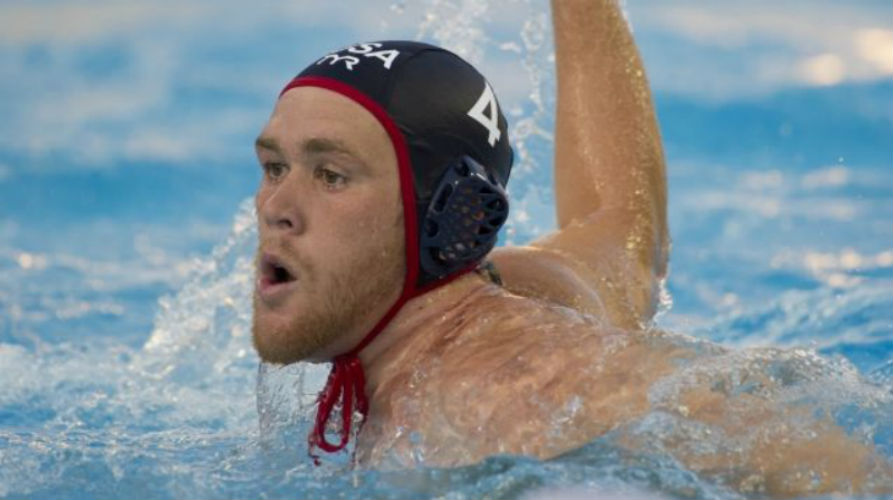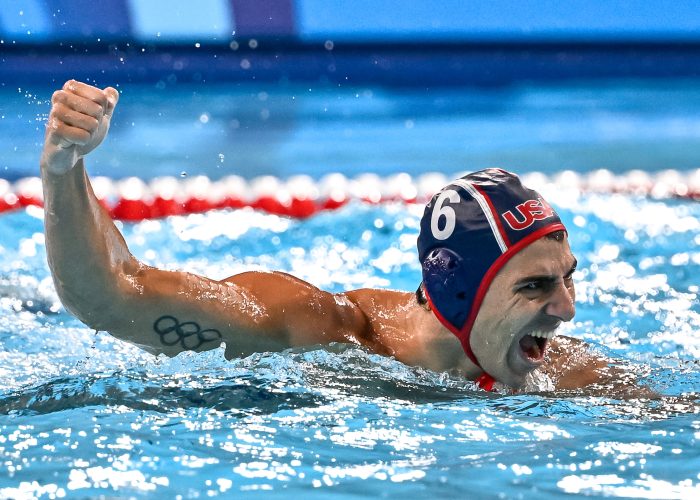The Best American Men’s Water Polo Players of the NCAA Era (Part II: No. 20 to No. 11)

The Best American Men’s Water Polo Players of the NCAA Era (Part II: No. 20 to No. 11)
By Jeff Moulton
In Part II of this three-part series, water polo expert Jeff Moulton discusses the individuals he has ranked No. 11 to 20 in his unofficial list of the top-25 American men’s water polo players of the NCAA era. Part I is linked below and also includes an explanation of the criteria used by Moulton to make his selections.

Luca Cupido of the United States.
20. Luca Cupido – attacker/center defender, Newport Harbor High School for one year and Cal (1x NCAA champion, 4x All-American, 3x 1st team All-American, 1x Cutino Award winner, 1x ACWPC Player of the Year, 3x Olympian, 1x bronze medalist).
Cupido has played professionally for Barcelona in Spain and Rari Nantes Camogli and CC Ortigia in Italy. Best known as an attacker, Cupido is also an excellent center defender. Cal coach Kirk Everist in a 2017 interview, “Cupido is by far the best two-meter defender in the country when I use him there.” In 2017, U.S. Olympic team coach Dejan Udovicic predicted that Cupido would play in multiple Olympics: “Luca is a true leader on the team. He can play different positions and is one of the most talented players I’ve ever coached. He has that X factor, which is a privilege only held by the highest-level players. Having that X factor gives him a bright future and a long career ahead. I can see him playing at the 2028 Olympic Games in Los Angeles.” Cupido is a dual-citizen of the United States and Italy. If he continues playing, he is likely to play for the United States in the 2028 Olympics. However, he deserves a spot on my list even if he doesn’t play another game. Once Cupido’s playing career is over, he is likely to be inducted into the Hall of Fame.
19. Peter Campbell – center defender, University High School and U.C. Irvine (1x NCAA champion, 4x All-American, 3x 1st team All-American, 1x ACWPC Player of the Year, 2x Olympian, 2x silver medalist, Hall of Fame).
I asked Craig Boyer, Campbell’s teammate on the 1988 Olympic team, what he remembers about Campbell. He said: “I don’t think I ever saw Peter make a bad decision in the pool. He was smart, strong and a great teammate! He played at the highest level on both offense and defense.” Jody Campbell, Peter Campbell’s teammate on the 1984 and 1988 Olympic teams: “Peter came through the Ted Newland ‘Animal Farm,’ which made him game-smart, loyal and willing to do whatever it takes as a player. In an era in which it was critical to be able to play one-on-one defense, including at 2 meters, he was tough, quick and smart.”
18. Jesse Smith – center defender, Coronado High School and Pepperdine (3x All-American, 2x 1st team All-American, 5x Olympian (Tony Azevedo is the only other American 5x water polo Olympian), 1x silver medalist, Hall of Fame).
Smith played professionally for Ethnikos Piraeus and Olympiacos in Greece, Mladost Zagreg in Croatia, Jadran Herceg Novi in Montenegro, Rari Nantes Savona in Italy, Galatasaray in Turkey, Paulista Sao Paulo in Brazil, and Gezira in Egypt. He is one of only a few athletes to turn down a scholarship offer from Dante Dettamanti at Stanford. Sacred Heart Prep coach Brian Kreutzkamp remembers playing against Smith’s Coronado High School teams when Kreutzkamp was coaching Newport Harbor High School: “Jesse Smith was one of the best, if not the best, 2M defenders I’ve coached against at the high school level. He was simply so strong he could move even the biggest and best centers from out of the center of the goal and would destroy any sort of offense we would try to run.” Smith also excelled in college. Terry Schroeder, Smith’s coach at Pepperdine, “Jesse is one of the best college water polo players ever.”
17. Craig Klass – LH center, Las Lomas High School and Stanford (2x NCAA champion, 3x All-American, 2x 1st team All-American, 1x ACWPC Player of the Year, 2x Olympian, 1x silver medalist, 1x FINA World Cup champion, Hall of Fame).
Klass was the best player and the second fastest swimmer (after former world record holder and 2x swimming Olympian Pablo Morales) on Stanford’s undefeated 1986 team. Stanford coach Dante Dettamanti speaking about Klass after Stanford won the 1986 NCAA Championship: “He’s a real gutsy power player. He’s the hardest worker I’ve ever had.”
16. James Bergeson – attacker, Newport Harbor High School and Stanford (2x CIF Southern Section Division 1 champion, 2x CIF Southern Section Division 1 Player of the Year, 2x NCAA champion, 4x All-American, 3x 1st team All-American, 1x Olympian, 1x silver medalist, Hall of Fame).
John Vargas, former Corona del Mel High School and Stanford coach, speaking about Bergeson’s time at Newport Harbor High School: “When Bergeson was playing, people wouldn’t go to watch the teams, they’d go to watch him. He did some unbelievable things.” One of Bergeson’s Newport Harbor High School teammates told me: “James was a freshman and I was a senior on the 1975 Newport Harbor HS team, then we were on the USA junior team. On both teams, he was far younger than everyone else and still outstanding. I was constantly amazed by his game.” Jody Campbell, Bergeson’s teammate at Stanford and on the 1988 Olympic team: “In an era in which movement was the basis of offense, nobody had more intensity and quickness than James.” Greg Boyer, Bergeson’s teammate on the 1988 Olympic team, remembers Bergeson’s shooting skills: “James had an amazing hesitation in his shooting motion. Many times a goalie would not even get his arms out of the water. On the 6-on-5, James was one of the best No. 1 position players in the world.”
15. Ryan Bailey – center, Millikan High School and U.C. Irvine (3x All-American, 1x 1st team All-American, 4x Olympian, 1x silver medalist, Hall of Fame).
Bailey scored 104 goals in his senior season at U.C. Irvine and led the 2012 United States Olympic team in scoring with 13 goals. Bailey had a distinguished professional career, playing for VK Jug Dubrovnik and VK Jadran Split in Croatia, Dynamo Moscow in Russia, Panionios in Greece, and VK Partizan in Serbia. At one time, Bailey was the highest-paid American professional water polo player. Hall of Fame player Tony Azevedo speaking about Bailey: “Ryan was one of the best centers in the world. He was simple. He’s bigger and stronger than you. He’s better than you.”
14. James Ferguson – attacker, Awalt High School and UCLA (1x NCAA champion, 2x All-American, 1x Olympian and would have been a 2x Olympian if the United States had qualified for the 1976 Olympics, 1x bronze medalist, Hall of Fame).
Ferguson played on UCLA’s varsity team from 1968 to 1970 (in those days, a freshman couldn’t play on the varsity team). UCLA’s 1969 team was undefeated, winning the first NCAA water polo tournament. A member of UCLA’s 1969 coaching staff told me: “The thing that impressed me most about James was his intensity, so absolutely intense at times that you knew you were in for a battle against him and he was never going to yield. He had what I might describe as a ‘steely, cold’ disposition as a player. His eyes said it all – ‘stay out of my way.’” Ferguson was a great shooter. In a 2015 interview with Rich Foster, Ferguson’s UCLA teammate and Hall of Fame player Eric Lindroth said that Ferguson was “incredible” at shooting the ball off the water. Ferguson was named to the all-world team in 1973.
13. Alex Bowen – attacker, Santana High School and Stanford (4x 1st team All-American, 3x Olympian, 1x bronze medalist).
Bowen, one of America’s greatest shooters, scored 253 goals in his four years at Stanford and has scored 31 goals in the Olympics, including 18 goals in the 2021 Olympics. Bowen has had a distinguished professional career, playing for Noisy-le-Sec in France, Partizan in Serbia, Apollon in Greece, Miskolci VLC in Hungary, and Mladost Zagreb in Croatia. A Hall of Fame coach told me, “Alex is a great perimeter shooter – truly one of the best in the world. What stands out even more is how he continues to evolve.” If Bowen continues playing, he is likely to play for the United States in the 2028 Olympics. However, he deserves a spot on my list even if he doesn’t play another game. Once Bowen’s playing career is over, he will almost certainly be inducted into the Hall of Fame.
12. Gary Figueroa – attacker, Sunny Hills High School and U.C. Irvine (3x All-American, 3x 1st team All American, 2x Olympian, 1x silver medalist, Hall of Fame).
Figueroa came a long way from his early days at Sunny Hills High School when, as his high school coach Jim Sprague remembers, he “was so small and weak he couldn’t lift a 10-pound bar with 2.5 pounds on each end.” Sprague, a member of the Hall of Fame, also said that Figueroa became “the greatest player I ever coached.” Figueroa was a great shooter. He holds the single-season scoring record at U.C. Irvine with 110 goals in 1977. Jody Cambell, Figueroa’s teammate on the 1984 Olympic team, told me: “Gary was a product of Ted Newland’s “Animal Farm,” and had a high IQ for the game. He was a prolific scorer. During his era, no one in the world was as quick, creative, and spontaneous as Gary. He had a pocket full of unique shots that would confuse and handcuff goalies. He mastered the “hesi” (hesitation) shot.” Figueroa was named to the all-world team in 1980.
11. Jon Svendsen – center defender, Miramonte and Cal (3x NCAA champion, 3x All-American, 1x NCAA Player of the Year, 2x Olympian and would have been a 3x Olympian if the United States had qualified for the 1976 Olympics, 1x silver medalist, Hall of Fame, 2x NCAA swimming All-American, Pac-10 champion in the 400-yard freestyle relay).
Svendsen started as a freshman on Miramonte High School’s first team in 1967, one of only two freshmen to start during Bill Brown’s 38 years as Miramonte’s coach. Svendsen was known for his physical play. As fellow Miramonte and Cal player John Schnugg remembers: “Jon was a mean son of a bitch who was feared the world over as an asshole to play against. Every team needs one. John Mann, Carlos Steffens, Greg Boyer, and Paul Becskehazy all come to mind, but Jon was in a class by himself. The USA team was at its best with him in the pool. His game was brute force, speed, and length with a great arm. His hands and balance were all world.” A Hall of Fame coach told me: “Jon Svendsen belongs in the top 10. Jon’s size, length, and speed made him incredibly versatile during his prime years from 1975-1980.”
In Part III of this series, Moulton will discuss the individuals he has ranked No. 1 to 10 in his unofficial list of the Top 25 American men’s water polo players of the NCAA era.



